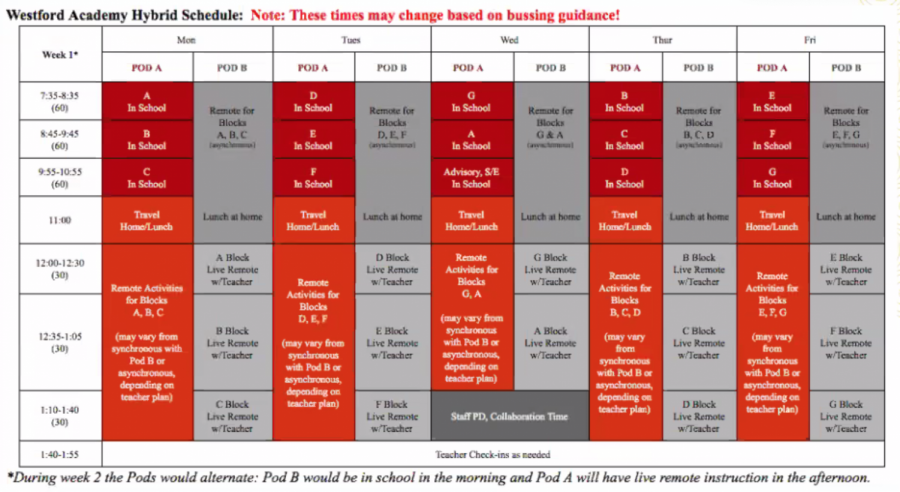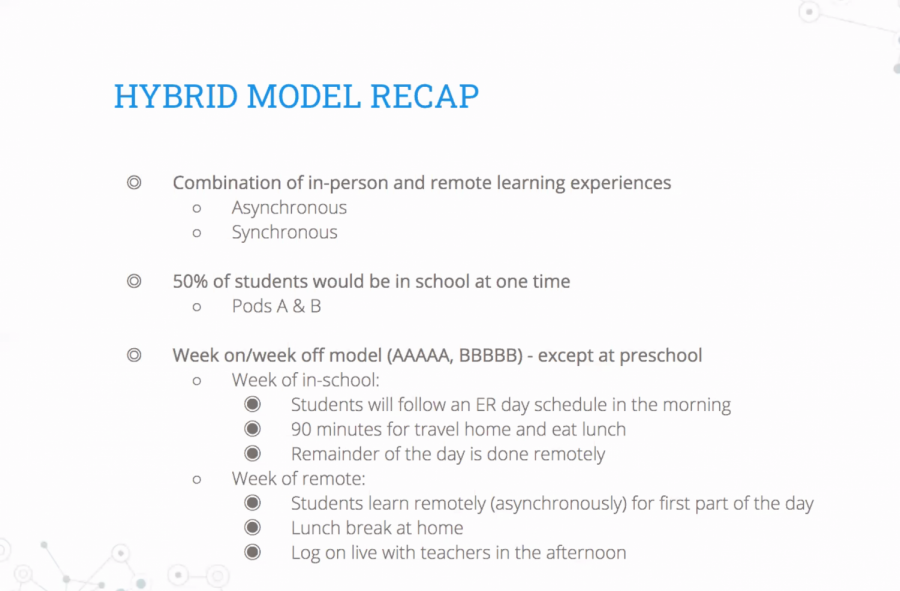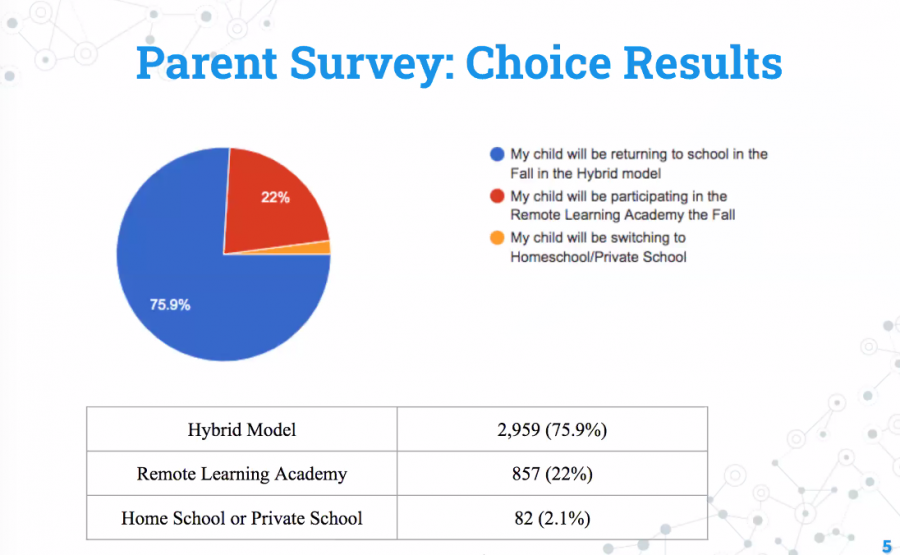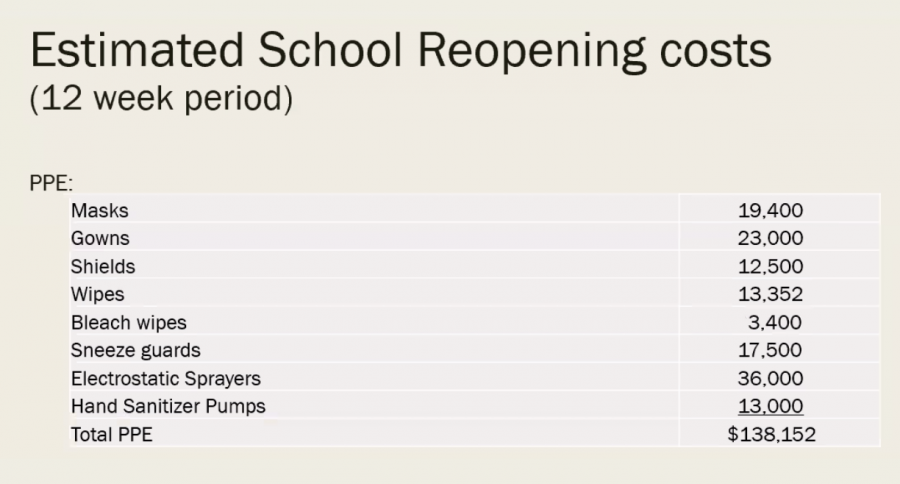School Committee meeting 8/5 updates hybrid model
August 6, 2020
With the ongoing spread of COVID-19, the Westford School Committee gathered for an online meeting on Wednesday, August 5, to continue discussing a safe reopening plan for Westford Public Schools. Although a final vote regarding the implementation of the hybrid model will occur on a later date, the meeting recapped and updated the details of the hybrid learning plan, and discussed the implications of the recent parent and staff surveys.
Overall, much of the hybrid model will remain the same: students will still follow an early release schedule with alternating weeks. They will be split into two groups, labeled Pod A and Pod B respectively, with both switching off between remote and in-school learning each week. One pod will follow an early release schedule in the morning and spend the remainder of the school day learning online, while another works solely remotely with live classes later in the day. Additionally, both groups would be given a 90 minute period in the middle of the day to eat lunch and travel back home if necessary.
Assistant Superintendent Kerry Clery stressed how this plan aligns with WPS’s main goal: to maximize safety and minimize risk for all students and faculty, without compromising the quality of education. Clery believes the WPS hybrid model takes into account student health, well-being, education, and budget in an extremely effective manner.
“The rationale [for the hybrid model] that we have is first and foremost the health and safety of our students. It’s very easy to get caught up in just thinking about academics; we are a school. […] Our priority is to try to get students back. […] The simple math is that less time [in school] equals less spread, as long as we can have an educationally sound alternative to being face to face, and we feel as though we have done that,” Clery said.
However, WPS updated some logistical details of the initially-presented hybrid plan to further enhance the current model.
To create pods, WPS has begun to explore ways to split Pods A and B geographically across Westford rather than by last names. Assistant Superintendent Clery explained that this method of stratification would be preferable to make transportation routes more convenient for buses and neighborhood collaboration at home.
“The students who are going in together will live near one another […] so if parents in their off week would like to get their [children] safely together to work with one another then they have the opportunity to do so,” Clery said.
The committee also proposed a Remote Learning Academy for students who are unable to attend school either because they have health concerns that could be triggered by the virus or parents who have chosen for them to study remotely. The program would provide students with pre-recorded courses taught by WPS staff. Currently, WPS is partnering with virtual learning platforms such as Edgenuity and Florida Virtual School that will provide further support for these students while at home.
At the high school level, Clery discussed the new possibility of creating live-stream opportunities in elective classes for remote students.
“There may be some electives at the high school level that we would be able to live-stream, depending on students’ schedules. We’re really going to take the students and look at their schedules and see what makes the most sense,” Clery said
In addition, WPS is partnering with different facilities in Westford to provide remote workspaces for families that may need child care support. There will also be a bus stop at those partner locations to make it easy for a child to be transported from his or her school.
“We know that the hybrid model can be disastrous for some families in terms of their work schedules, and it’s very inconvenient. […] So, the Superintendent had thought about working with different centers throughout Westford, and the goal is to partner with local organizations to support child care concerns for families. […] It won’t be like an after school rec[reation] department program because students are expected to be in school,” Clery said.
Although parents are in favor of the hybrid model, committee members expressed their concern for the hybrid model due to previous community backlash, the inconvenience for working families, and the fact that much of the information presented that night wasn’t given to the committee members beforehand. Some additional concerns regard staff members who live out-of-state and the extended duties given to custodians such as after-school deep-cleaning. This opens up the possibility of hiring new staff, which not all committee members support at the moment.
According to a parent survey released weeks prior to the meeting, 75.9% of all parent respondents chose the hybrid model, compared to 22% who chose the remote learning option. As for the staff, while approximately 60% of staff felt as though the hybrid model is an appropriate balance of student education, health, and well-being, staff members are approximately evenly split between preferring the hybrid or remote models.
In addition, safely reopening schools in the fall with the hybrid model totals to an initial cost of $1,096,152. This also means that WPS will have a loss in revenue of approximately $1,945,000 due to a lack of normal kindergarten/preschool, bus, and activity fees.
As a result, many committee members stated that they were not comfortable taking a final vote for implementing the hybrid model until more information is available and the plan can be made accessible for all families.
Committee member Chris Sanders stated that he is unsure how the logistics of the plan will unfold when it is implemented in the fall and feels as though more planning should be put into the current remote plan in case the hybrid learning model falls flat.
“The thing I can’t reconcile is how we go from remote to hybrid and back. I don’t see how this plan does that. […] If this hybrid plan goes perfectly I think that it’s a really great plan, but my concern is that if things don’t go well, what will we do? […] I need to see more in the remote plan and the child care and community concerns,” Sanders said.
On the other hand, committee member Mingquan Zheng voiced his support of the hybrid learning plan, believing that it would give students the opportunity to create meaningful connections with their new teachers and peers in-person.
“I have a different take on when to start […] I’m more concerned about the school being shut down during flu season, so I think we should get as much in-person education as possible before Thanksgiving break. By that time if we decide to go full-remote, we will have given kids valuable time to get to know their teachers and peers,” Zheng said.
Due to the conflicting views of the committee members, as well as the lack of information and community backlash, the committee has decided to have another meeting next week to hold the final vote.
Ultimately, Superintendent Bill Olsen believes that there is no perfect plan for reopening schools, and what’s most important is making sure the needs of all students and families are met.
“There’s no perfect plan for the return hybrid. For every positive comment about a hybrid plan, you’ll have another from someone who is not in favor of it. What we should try to do is […] think of the instruction students need, all while complying with the Department of Public Health, and the Department of Education [to ensure the safety of all students],” Olsen said.



